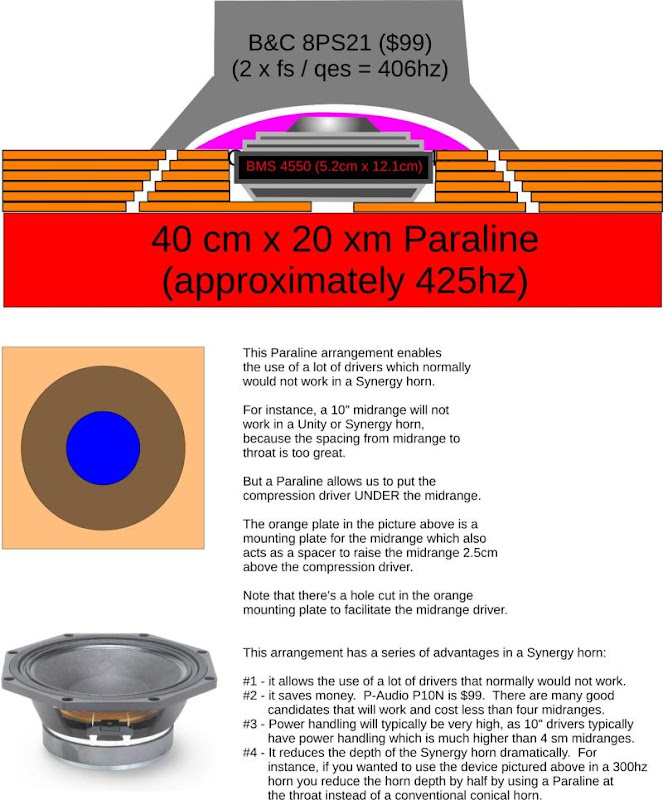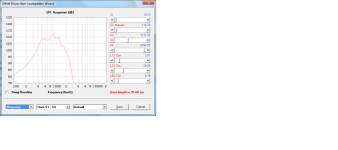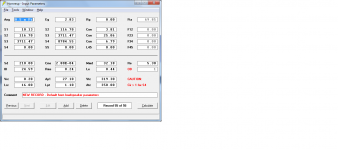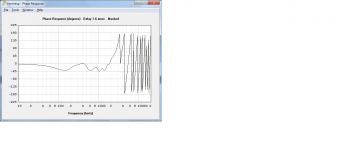I can understand where GM is coming from, and if you simplify the Tractrix or Le Cleac'h shapes in HornResp, you end up with straight sides for a lot of the horn anyway 🙂
Once you have the schematic in the program drawn, export the data, and type in an 'appropriately high' increment for the divisions. HornResp looks like it adjusts for the simplicity, which is a brilliant feature!
Once you have the schematic in the program drawn, export the data, and type in an 'appropriately high' increment for the divisions. HornResp looks like it adjusts for the simplicity, which is a brilliant feature!
Well, I've mocked up the Synergy horn based on the adjusted parameters on the previous page, and it's big! But, again, it almost fits!
In order for it to meet the front of the sub and take the compression driver into account, I'd have to shorten the horn by about 5.5".
Doing that seemed to make the horn looking less insane...tomorrow I'll assemble the 3 sections properly to see what it's actually like.
In order for it to meet the front of the sub and take the compression driver into account, I'd have to shorten the horn by about 5.5".
Doing that seemed to make the horn looking less insane...tomorrow I'll assemble the 3 sections properly to see what it's actually like.
Sorry for the delayed update. It's been busy, so I've spent the last few days (when I've been able to think about the speakers) going around and around in my head, based on the size of the horn required for pattern control.
So, for now, I've gone back to Bill's spreadsheet, and am replicating his design, with the exception of adjusting the throat for the larger compression driver I have in comparison to his.
Again, I'm using cardboard as a mock-up, and they look quite nice in terms of size. I've glued it together using silicone sealant (I have a big tube of it left over after another experiment), so while it's setting I thought I'd write about it 🙂
Given that this is a 2-way design and only has one cone driver, I'm trying to work out where to put the port(s). I've not been able to find the post in this thread, but is it related to 1/4 of the wavelength of the crossover frequency between the two drivers?
So, for now, I've gone back to Bill's spreadsheet, and am replicating his design, with the exception of adjusting the throat for the larger compression driver I have in comparison to his.
Again, I'm using cardboard as a mock-up, and they look quite nice in terms of size. I've glued it together using silicone sealant (I have a big tube of it left over after another experiment), so while it's setting I thought I'd write about it 🙂
Given that this is a 2-way design and only has one cone driver, I'm trying to work out where to put the port(s). I've not been able to find the post in this thread, but is it related to 1/4 of the wavelength of the crossover frequency between the two drivers?
I had this discussion recently with horn enthusiasts in the world. Apparently some believe the sound of port is not at all compatible with the sound of horn. Better to use more drivers like in an array than try to combine a horn with a ported midbass speaker.
Could you show your plan again? If you use a midbass horn, where would you fit a ported speaker if it is just a 2-way?
Could you show your plan again? If you use a midbass horn, where would you fit a ported speaker if it is just a 2-way?
AllenB, that's what I'd found too.
Ok, so based on Art's information, I've cobbled together a small drawing as a proof of concept. It's not to scale, but I imagine that rather than worrying about a specific port, I can use the chamber of the enclosure itself as one, provided I can get the tuning right.
Would this make sense?

The yellow areas of the horn are a guess at where the ports would go.
Aha, nvm.
I have no idea what that is.
unahm, Im not sure where you are up to with modeling the ports but just a few thoughts.
L12 in your model is only 2.5cm from the throat. There is no way to physically fit any sort of port that close to the throat.
From what I am gathering you plan to mount the driver directly behind the compression driver and use multiple ports on each side of the throat, similar to what Danley does with his coaxial synergies.
In this case I would model something like this.
L12 in your model is only 2.5cm from the throat. There is no way to physically fit any sort of port that close to the throat.
From what I am gathering you plan to mount the driver directly behind the compression driver and use multiple ports on each side of the throat, similar to what Danley does with his coaxial synergies.
In this case I would model something like this.
Attachments
unahm, Im not sure where you are up to with modeling the ports but just a few thoughts.
L12 in your model is only 2.5cm from the throat. There is no way to physically fit any sort of port that close to the throat.
From what I am gathering you plan to mount the driver directly behind the compression driver and use multiple ports on each side of the throat, similar to what Danley does with his coaxial synergies.
In this case I would model something like this.
I've no idea why I'd not thought of that (actually I do, lots of sleep deprivation at the moment!), but it seems like a more simple solution, and mitigates the problems we can see with offset drivers!
I'm not sure about the S1-S2 bit, as Bill's spreadsheet doesn't seem to show that 'section'...maybe it's put in there to compensate with something in HornResp. Either that, or it's the flare for the tweeter..?
New babies do tend to hinder the design process 🙂.I've no idea why I'd not thought of that (actually I do, lots of sleep deprivation at the moment!), but it seems like a more simple solution, and mitigates the problems we can see with offset drivers!
DSL's coax driver arrangements using a 5" allow for a very small throat chamber for the mids.
Placing an 8" behind the HF driver would make a small throat chamber almost impossible to build, so it would roll off well below the crossover point you desire.
In addition, the HF driver preferably should be behind the mid driver for time alignment, though with DSP that could be corrected.
As far as Rewind's statement "Apparently some believe the sound of port is not at all compatible with the sound of horn", he must have missed out talking with the vast population of old school Altec Voice of the Theater owners, and the many other similar designs all using BR/horn combinations,
in addition to the more recent DSL and others continuing the tradition, but using smaller drivers and enclosures.
Art
That it does Art! My other daughter was unwell last night too, so that only added to the fun! 😀
Because of that, and I don't know why I did it, but here's my visual understanding of Beau's post:

This is based on the 2-part Tractrix horn design I drew earlier in this thread, just as something to 'plug it to'.
I'd guess that mounting like this will present challenges of getting the ports to the throat of the horn, seeing as there's pretty much no physical way of doing that where the throat is smaller than the compression driver.
I did have a thought though...

The green area in both pictures is 'air volume' that can be used by the cone driver. This is probably overkill, but could running the ports around to the sides of the throat (so it effectively works like an offset driver) work? In my head, it would seem like the ports would be easier to get closer to the throat of the horn that way...
Because of that, and I don't know why I did it, but here's my visual understanding of Beau's post:

This is based on the 2-part Tractrix horn design I drew earlier in this thread, just as something to 'plug it to'.
I'd guess that mounting like this will present challenges of getting the ports to the throat of the horn, seeing as there's pretty much no physical way of doing that where the throat is smaller than the compression driver.
I did have a thought though...

The green area in both pictures is 'air volume' that can be used by the cone driver. This is probably overkill, but could running the ports around to the sides of the throat (so it effectively works like an offset driver) work? In my head, it would seem like the ports would be easier to get closer to the throat of the horn that way...
Here's a little bit more of sleep-deprived noodling. I've super-imposed my guess of a Paraline onto that 2-piece Tractrix horn where I thought it would go (as a representation):

I was thinking that maybe I could combine the drivers, much like Patrick Bateman suggested in post #655 of his Square Pegs thread:

I know the consensus is that the Paraline has to equate to the lowest wavelength, but what if the Paraline becomes part of the horn? Would it still load in the same way?
It seems like it would be a possibility to remove some of the longer, more conical throat length of the horn, and then just have the flare return to the standard shape? You could combine multiple drivers into the desired 'point source', whilst also reducing the length of the horn itself.
Or am I insane? 🙂

I was thinking that maybe I could combine the drivers, much like Patrick Bateman suggested in post #655 of his Square Pegs thread:

I know the consensus is that the Paraline has to equate to the lowest wavelength, but what if the Paraline becomes part of the horn? Would it still load in the same way?
It seems like it would be a possibility to remove some of the longer, more conical throat length of the horn, and then just have the flare return to the standard shape? You could combine multiple drivers into the desired 'point source', whilst also reducing the length of the horn itself.
Or am I insane? 🙂
Last edited:
Hang on - I am. Art has already mentioned earlier on in this thread that a Paraline probably isn't suitable for home use, as it can give a ragged response. It's a shame, but at least I've remembered that I've brought myself full-circle on that, albeit quite briefly!
Your second diagram on the last page is exactly what I was talking about. Vc can be made very small to reduce hf losses.
the only reason for the paraline I believe is to achieve exstreme sound pressure (by 'assembling' the output from multiple drivers)
So apart from the Paraline and the Synergy horn designs, are there any other options for coherence of multiple drivers?
... any other options for coherence of multiple drivers?
yes, crossover 😉
Sitting at equal distance from their acoustic centers, or using DSP to time align.So apart from the Paraline and the Synergy horn designs, are there any other options for coherence of multiple drivers?
The reason I suggested a Synergy was the simplicity of construction compared to two separate horns, as well as the virtual point source.
You have circled the runway many times now, eventually you will run out of fuel, hope the landing is soft 😉.
🙂
I'm often known for 'flogging a dead horse'!
Still, I wanted to bring a conclusion that everyone would be aware of - so making a Synergy horn continues 🙂
I have the horn together, I just need to put the drivers on it, and then work out what I need to do in order to get the right volume for the Alpha 8.
I'm often known for 'flogging a dead horse'!
Still, I wanted to bring a conclusion that everyone would be aware of - so making a Synergy horn continues 🙂
I have the horn together, I just need to put the drivers on it, and then work out what I need to do in order to get the right volume for the Alpha 8.
- Status
- Not open for further replies.
- Home
- Loudspeakers
- Multi-Way
- Midbass horn


